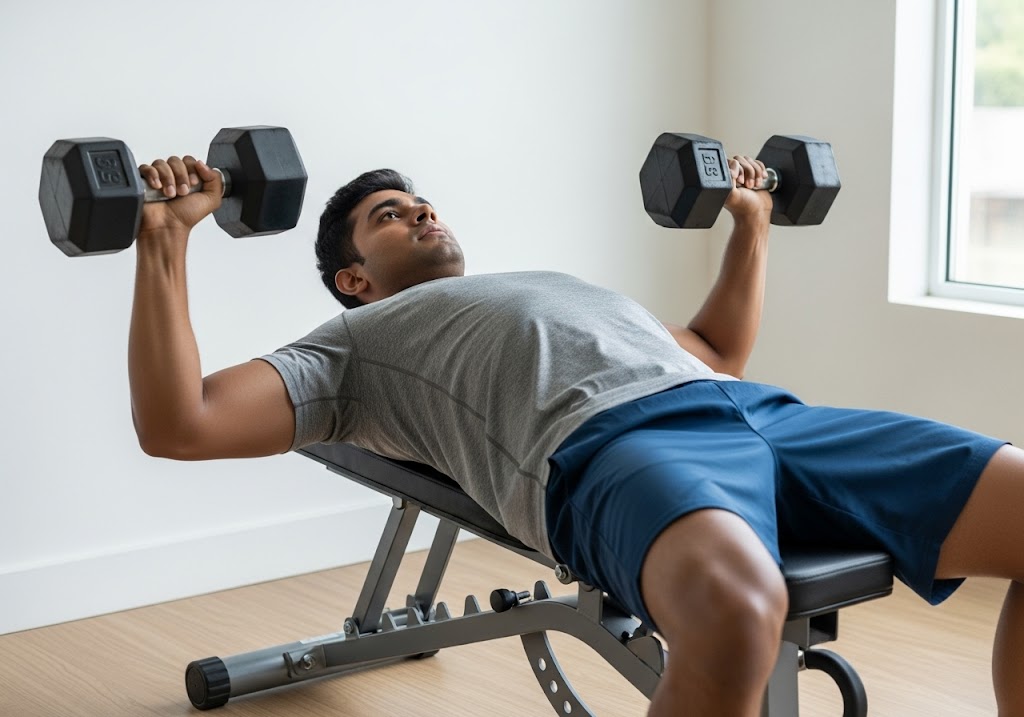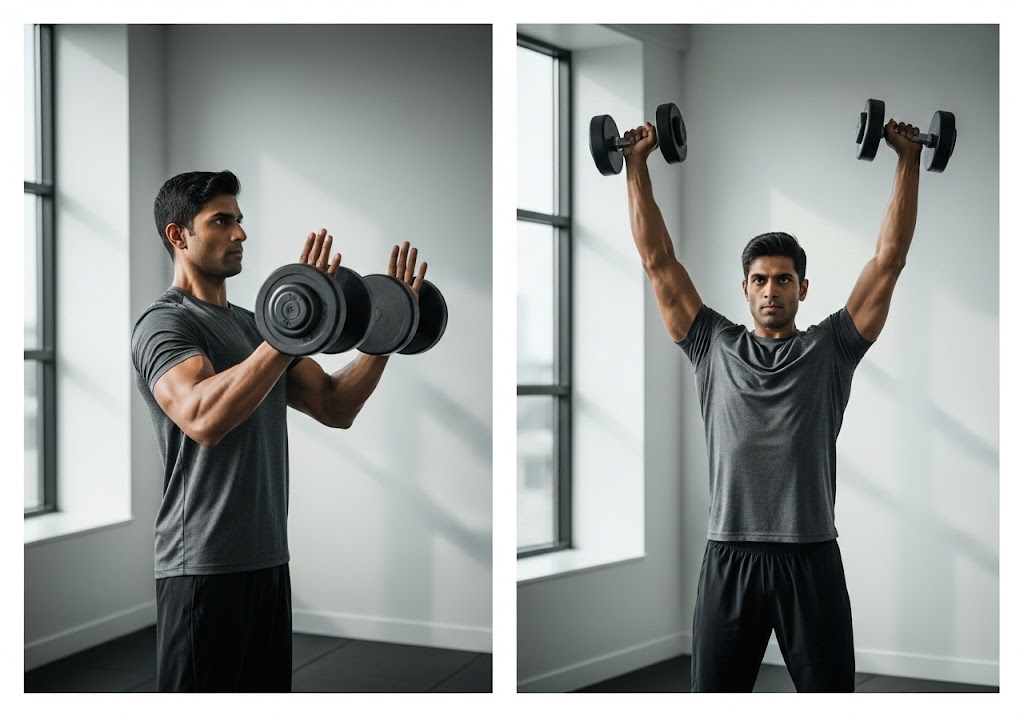Arnold Press vs Dumbbell Press differs in that Arnold press involves rotation for better shoulder mobility and muscle activation, while dumbbell press allows heavier weights for strength building. Arnold Press vs Dumbbell Press represents one of the most debated shoulder exercise comparisons in fitness training. Both movements target shoulder muscles effectively but through different mechanisms and movement patterns that impact results differently.
When choosing between these popular shoulder exercises, understanding their unique characteristics helps optimize your training approach. The Arnold press incorporates rotational movement throughout the range of motion, while the traditional dumbbell press follows a straight vertical path. Each exercise offers distinct advantages for muscle development, strength building, and functional movement patterns.
Both exercises serve important roles in shoulder training programs. Your choice between Arnold Press vs Dumbbell Press should align with your specific fitness goals, experience level, and physical capabilities. This analysis examines every aspect of both movements to help you make the best decision for your shoulder training needs.
Table of Contents
Understanding Arnold Press vs Dumbbell Press Fundamentals
The fundamental difference between Arnold Press vs Dumbbell Press lies in their movement mechanics and muscle activation patterns. These exercises target similar muscle groups but engage them through distinctly different pathways, creating unique training stimuli and adaptation responses.
Arnold press starts with palms facing your body and rotates outward during the pressing motion. This rotational component engages additional stabilizer muscles and provides a longer range of motion compared to traditional pressing movements. The exercise was popularized by Arnold Schwarzenegger, who used it to build his legendary shoulder development during his bodybuilding career.
| Aspect | Arnold Press | Dumbbell Press |
|---|---|---|
| Starting Position | Palms face body | Palms face forward |
| Movement Pattern | Rotation + Press | Straight vertical press |
| Range of Motion | Extended | Standard |
| Complexity Level | Higher | Lower |
| Muscle Activation | Multi-planar | Single plane |
| Learning Curve | Steeper | Gentler |
| Weight Capacity | Moderate | Higher |
Traditional dumbbell shoulder press maintains a consistent hand position throughout the movement. The palms face forward from start to finish, allowing for heavier weight loads and simpler movement execution. This straightforward approach makes it accessible to beginners while still providing effective stimulus for experienced lifters seeking maximum load progression.

Arnold Press vs Dumbbell Press: Muscle Growth (Hypertrophy)
Muscle growth potential differs significantly between Arnold Press vs Dumbbell Press due to their distinct movement patterns and muscle activation profiles. The rotational component of Arnold press creates unique tension patterns that may enhance hypertrophy through different mechanisms than traditional pressing movements.
| Growth Factor | Arnold Press | Dumbbell Press |
|---|---|---|
| Time Under Tension | Higher (rotation adds time) | Moderate |
| Muscle Activation | Multi-angle stimulation | Single-angle focus |
| Stabilizer Engagement | High | Moderate |
| Load Potential | Moderate (15-25kg typically) | High (20-40kg typically) |
| Hypertrophy Rating | 8/10 | 7/10 |
| Beginner Suitability | 6/10 | 9/10 |
Arnold press provides superior muscle growth stimulus through its extended range of motion and multi-planar activation. The rotational movement engages shoulder muscles from various angles, potentially leading to more complete development. However, the complexity may limit weight progression compared to traditional dumbbell pressing.

Arnold Press vs Dumbbell Press: Functional Strength Transfer
Functional strength transfer varies considerably when comparing Arnold Press vs Dumbbell Press applications to real-world activities and sports performance. The movement patterns of each exercise translate differently to everyday tasks and athletic movements.
| Transfer Aspect | Arnold Press | Dumbbell Press |
|---|---|---|
| Daily Activities | High (mimics natural arm movement) | Moderate |
| Sports Performance | Excellent for rotational sports | Good for overhead activities |
| Movement Quality | Enhances shoulder mobility | Builds raw pressing strength |
| Coordination Development | Advanced | Basic |
| Real-world Application | 9/10 | 7/10 |
The rotational nature of Arnold press better mimics natural arm movements found in daily activities like reaching, throwing, and lifting objects at various angles. This makes it superior for functional strength development compared to the more linear dumbbell press movement pattern.
Arnold Press vs Dumbbell Press: Calorie Burn
Calorie expenditure differences between Arnold Press vs Dumbbell Press stem from movement complexity, muscle recruitment patterns, and exercise duration requirements. The additional rotational component affects energy demands significantly.
| Calorie Factor | Arnold Press | Dumbbell Press |
|---|---|---|
| Energy Expenditure per Rep | Higher | Lower |
| Muscle Groups Engaged | More comprehensive | Focused |
| Movement Duration | Longer per rep | Shorter per rep |
| Stabilizer Demand | High | Moderate |
| Calories per 10 reps | 15-20 | 12-16 |
| Total Workout Burn | Higher | Lower |
Arnold press burns approximately 20-25% more calories per repetition due to increased movement complexity and extended time under tension. The rotational component requires additional energy expenditure from stabilizing muscles throughout the movement pattern.
Learn more about maximizing your calorie burn with our how to burn 500 calories a day strategies.

Arnold Press vs Dumbbell Press: Progressive Overload Potential
Progressive overload capabilities differ substantially between Arnold Press vs Dumbbell Press due to movement complexity limitations and loading potential. Understanding these differences helps plan long-term strength development strategies.
| Overload Factor | Arnold Press | Dumbbell Press |
|---|---|---|
| Maximum Load Potential | Moderate (form limits weight) | High |
| Progression Rate | Slower | Faster |
| Load Increments | 1-2.5kg increases | 2.5-5kg increases |
| Strength Ceiling | Lower | Higher |
| Long-term Progression | 6/10 | 9/10 |
| Form Maintenance | Challenging at heavy weights | Easier to maintain |
Traditional dumbbell press allows for superior progressive overload due to its simpler movement pattern. Lifters can typically handle 20-30% heavier weights compared to Arnold press, leading to greater absolute strength gains over time.
Arnold Press vs Dumbbell Press: Shoulder Mobility & Range of Motion
Shoulder mobility benefits vary significantly between Arnold Press vs Dumbbell Press, with the rotational movement providing distinct advantages for joint health and flexibility development. Movement quality improvements impact long-term shoulder function.
| Mobility Aspect | Arnold Press | Dumbbell Press |
|---|---|---|
| Range of Motion | Extended (rotation adds 30-40°) | Standard |
| Flexibility Benefits | High | Moderate |
| Joint Mobility | Improved through multiple planes | Single plane improvement |
| Shoulder Health | Excellent | Good |
| Mobility Rating | 9/10 | 6/10 |
| Rehabilitation Value | High | Moderate |
The rotational component of Arnold press takes shoulders through a more complete range of motion, promoting better joint health and mobility. This extended movement pattern helps maintain shoulder flexibility and may reduce injury risk over time.

Arnold Press vs Dumbbell Press: Joint Safety / Injury Risk
Safety considerations between Arnold Press vs Dumbbell Press involve different risk factors and injury prevention strategies. Movement complexity impacts joint stress patterns and injury potential significantly.
| Safety Factor | Arnold Press | Dumbbell Press |
|---|---|---|
| Injury Risk Level | Moderate (complexity factor) | Lower |
| Common Injury Areas | Shoulder impingement, wrist strain | Shoulder joint, lower back |
| Form Difficulty | High | Low |
| Beginner Safety | 6/10 | 8/10 |
| Load-related Risk | Lower due to weight limits | Higher with heavy loads |
| Joint Stress | Distributed | Concentrated |
Arnold press carries moderate injury risk due to its complex movement pattern, which requires excellent form and shoulder mobility. However, lighter weights typically used reduce absolute stress on joints compared to heavy dumbbell pressing.
Arnold Press vs Dumbbell Press: Muscle Activation
Muscle activation patterns differ considerably between Arnold Press vs Dumbbell Press, affecting which muscle fibers receive primary stimulus and how effectively each exercise targets intended muscle groups.
| Activation Aspect | Arnold Press | Dumbbell Press |
|---|---|---|
| Primary Muscle Activation | Multi-angle deltoid recruitment | Direct anterior deltoid focus |
| Secondary Muscle Involvement | High | Moderate |
| Stabilizer Activation | Excellent | Good |
| Core Engagement | High | Moderate |
| Overall Activation | 9/10 | 7/10 |
| Muscle Balance | Superior | Good |
The rotational movement of Arnold press activates shoulder muscles from multiple angles, providing more complete muscle fiber recruitment. This comprehensive activation pattern may lead to better muscle balance and development symmetry.

Arnold Press vs Dumbbell Press: Time Under Tension (TUT)
Time under tension differences between Arnold Press vs Dumbbell Press significantly impact muscle building potential and metabolic stress accumulation. Movement duration affects hypertrophy stimulus quality.
| TUT Factor | Arnold Press | Dumbbell Press |
|---|---|---|
| Rep Duration | 4-6 seconds | 2-3 seconds |
| Eccentric Phase | Extended | Standard |
| Concentric Phase | Longer due to rotation | Shorter |
| Total Set TUT | 60-90 seconds | 30-45 seconds |
| Hypertrophy Benefit | Higher | Moderate |
| Metabolic Stress | Greater | Lower |
Arnold press provides 50-80% longer time under tension per repetition due to the rotational component extending movement duration. This increased TUT creates superior conditions for muscle growth and metabolic adaptations.
Arnold Press vs Dumbbell Press: Control & Stability Development
Control and stability requirements vary dramatically between Arnold Press vs Dumbbell Press, affecting neuromuscular development and coordination improvements. Movement complexity challenges different aspects of motor control.
| Control Aspect | Arnold Press | Dumbbell Press |
|---|---|---|
| Stability Demand | Very High | Moderate |
| Coordination Required | Advanced | Basic |
| Balance Challenge | Significant | Minimal |
| Motor Learning | Complex | Simple |
| Stability Rating | 9/10 | 6/10 |
| Neuromuscular Development | Superior | Good |
The multi-planar movement of Arnold press demands exceptional stability and control, leading to superior neuromuscular adaptations. This enhanced stability training transfers well to other exercises and daily activities.

Arnold Press vs Dumbbell Press: Equipment Accessibility
Equipment requirements and accessibility differ between Arnold Press vs Dumbbell Press, affecting exercise selection based on available training facilities and home workout setups.
| Accessibility Factor | Arnold Press | Dumbbell Press |
|---|---|---|
| Equipment Needed | Dumbbells only | Dumbbells only |
| Space Requirements | Standard | Standard |
| Home Gym Suitability | Excellent | Excellent |
| Gym Availability | Universal | Universal |
| Cost Barrier | None | None |
| Setup Complexity | Simple | Simple |
Both exercises require identical equipment and space, making accessibility equal. The choice between Arnold Press vs Dumbbell Press should be based on training goals and capabilities rather than equipment limitations.
Explore calisthenics at home no equipment options if dumbbells aren’t available.
Arnold Press vs Dumbbell Press: Benefits
The overall benefits comparison between Arnold Press vs Dumbbell Press reveals distinct advantages that appeal to different training objectives and fitness levels. Understanding these benefits helps optimize exercise selection.
Both exercises offer unique advantages for shoulder development and overall fitness goals. Arnold press excels in muscle activation variety, functional movement patterns, and shoulder mobility enhancement. Its rotational component provides comprehensive muscle fiber recruitment that traditional pressing movements cannot match.
- Arnold Press Benefits – Enhanced shoulder mobility through rotational movement, superior muscle activation from multiple angles, improved functional strength transfer to daily activities, better time under tension for hypertrophy, excellent stability and coordination development
- Dumbbell Press Benefits – Higher loading potential for maximum strength gains, simpler movement pattern suitable for beginners, faster progression rates due to reduced complexity, lower injury risk with proper form, easier integration into existing training programs
- Shared Benefits – Target same primary muscle groups, require identical equipment setup, suitable for home workouts, scalable across fitness levels, effective for muscle building goals
Arnold Press Advantages
Arnold press provides superior muscle activation through its multi-planar movement pattern. The rotational component engages stabilizer muscles more effectively while promoting better shoulder joint health through increased mobility demands.
Dumbbell Press Advantages
Traditional dumbbell press allows for heavier loading and faster strength progression. The simpler movement pattern reduces learning curve requirements while still providing effective stimulus for muscle growth and strength development.
For complete upper body development, consider incorporating push ups vs bench press variations into your routine.
Conclusion
The Arnold Press vs Dumbbell Press comparison reveals that both exercises serve important but different roles in shoulder training. Arnold press excels for mobility, muscle activation variety, and functional strength, while dumbbell press dominates for maximum loading and strength progression. Your choice should align with specific training goals and experience level.
Want to master the calisthenics handstand and take your skills to the next level? Whether you’re a beginner or pushing advanced skills, ISC – Indian School of Calisthenics offers expert guidance to help you master bodyweight training. Visit us at SRPF Ground, NH8, Goregaon (E), Mumbai – 400065. For class schedules, personalized coaching, or more details, call +91 77159 53218. Train smart, move better, and unlock your back strength with ISC.
Arnold Press vs Dumbbell Press – FAQs
Which is better for muscle growth, Arnold Press vs Dumbbell Press?
Arnold press provides better muscle growth due to increased time under tension and multi-angle muscle activation compared to dumbbell press.
Can beginners safely perform Arnold Press vs Dumbbell Press?
Dumbbell press is safer for beginners due to simpler movement pattern, while Arnold press requires more experience and mobility.
Which exercise allows heavier weights, Arnold Press vs Dumbbell Press?
Dumbbell press allows 20-30% heavier weights due to simpler movement mechanics compared to Arnold press complexity.
How do Arnold Press vs Dumbbell Press compare for shoulder mobility?
Arnold press significantly improves shoulder mobility through rotational movement, while dumbbell press provides limited mobility benefits.
Which burns more calories, Arnold Press vs Dumbbell Press?
Arnold press burns 20-25% more calories per repetition due to increased movement complexity and muscle engagement.
Are Arnold Press vs Dumbbell Press equally safe for shoulders?
Dumbbell press is generally safer for shoulders, while Arnold press requires better form and mobility to avoid injury.
Which exercise is better for functional strength, Arnold Press vs Dumbbell Press?
Arnold press provides superior functional strength transfer due to rotational movement pattern mimicking daily activities.
How do Arnold Press vs Dumbbell Press compare for progressive overload?
Dumbbell press offers better progressive overload potential with heavier weights and faster progression rates than Arnold press.
Which exercise requires more stability, Arnold Press vs Dumbbell Press?
Arnold press demands significantly more stability and coordination due to its complex rotational movement pattern.
Should I choose Arnold Press vs Dumbbell Press for my workout?
Choose Arnold press for mobility and muscle activation variety, or dumbbell press for maximum strength and simpler progression.


